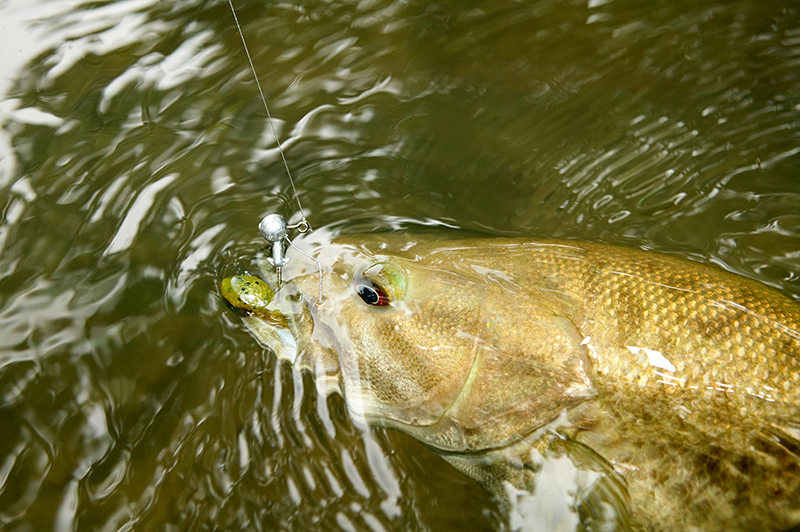My Favorite Smallmouth Bass Techniques

My Favorite Smallmouth Bass Techniques
As a child growing up, my summer vacations were filled with fishing adventures, from the local lakes and creeks to our annual family vacation to Catch’N Fish resort on Big Bass Lake (seriously, that was the name of the place). Early mornings in the pre-dawn hours, the dads would load up the boats and go after walleyes. For years, I was “too young” to go out with them and had to wait for the afternoon trip to go out with the family and fish for panfish.
In order to occupy myself, I roamed the resort’s docks that were surrounded by a sandy shoreline with scattered rocks and lilypads. This was home to many bluegills, small perch, pike, and smallmouth bass. It was here that I fell in love with smallmouth bass as a species. These hard-biting, fierce-fighting, acrobatic fish were a thrill for a young angler and still are today. Here are some of my favorite ways to catch these wonderful sportfish in a lake or reservoir setting.
Topwater
From Poppers to Prop Baits, these baits are fun and easy to fish and really produce under the right conditions (typically in the warmer months). Fished with a steady cadence or retrieve, I am looking for rocky shorelines, points, or rockpiles, and weed beds and edges to make my casts. Oftentimes, I will vary my cadence with longer or shorter pauses when fishing a popper until I determine the mood of the fish. I keep track of my cadence by counting in my head on the pause in between ‘pops’.
When fishing a prop-style bait, I will change the speed of my retrieve until I determine what the fish prefer. As a general rule of thumb, I will fish slower, longer pause with a popper and slower retrieve with a prop bait when fishing around vegetation. Conversely, I will fish faster, shorter pause with the popper, and faster retrieve with a prop bait when fishing around rocks. There are always exceptions, and I encourage you to experiment.
Jerkbaits
For me, there are essentially two types of jerkbaits-soft plastics and hardbaits/crankbaits, and I fish each one differently and for slightly different applications. I especially like jerkbaits early on in the season in cooler water or after a cold front rolls through. For soft plastic jerkbaits, or flukes as some people call them, I typically choose a jerk shad or minnow (in the 4” size range) and rig them on an offset worm hook, rigged weedless. My trick to add weight if I need to fish down in the weeds is to choose a keel-weighted offset worm/swimbait hook or a weighted hook.
If I fish an unweighted hook, I can fish my fluke above the weeds, and it has a slow fall if I pause it. A keel weighted hook allows me to fish down in the weeds and not get snagged up, as well as increase my cast range. I impart an erratic action to these baits by jerking or twitching my rod tip and giving a little slack back on the retrieve. This is sometimes called ‘walking the dog’ and results in a side-to-side motion in the bait which fish love. For hard plastic jerkbaits, there are now a lot of new options that are outstanding.
My beginning cadence is typically to cast the lure, crank lure to depth, pause three seconds, tap/small jerk, pause three seconds, tap/small jerk, pause three seconds, tap/small jerk, pause three seconds, if no strikes, crank lure to reposition on structure and repeat pause-tap cadence until lure is back or I catch a fish. I will experiment with initial crank to depth, length of pauses, and intensity of taps. Typically, I fish faster and more aggressively in warmer water and slower and more methodically in cooler water or post-cold front. There are a lot of relatives and variables, so it pays to experiment but keep track mentally so when you catch a fish, you can re-create what you were doing.
Tubes and Craws
Smallmouth LOVE rocks, and one of their favorite foods is crawfish. Replicating these clawed delicacies will help you put more bass in the boat. A noted angler once told me that you can fish any color tube you want as long as it’s green. While there is some truth to that, I have expanded my tube color palette to include brown and black for smallies. I still love a 3 ½” Green Pumpkin color tube with a solid nose stuffed with a 1/8oz to ¼ oz tube jig. I like to target the shadows of larger rocks and boulders, where hungry smallmouth wait to ambush unsuspecting prey while staying out of the sun.
Sometimes you don’t feel the strike, so it is important to watch your line to see if it starts to move off to the side. I don’t charge extra for hooksets in my guide boat, so I tell clients that if they feel or see something unusual, they promptly set the hook. As for Craws, I like to fish them on two distinct types of jigs-a skirted swim jig and a football style jig head. I typically rig the skirted swim jig with a craw that has larger/flatter appendages that can flap and undulate as I am ‘swimming’ the lure back to the boat after a cast. I like this rig when fishing in and around wood stumps, emergent trees, and submerged brush.
When fishing around rocky structure (points, reefs), I like a football-style jig head. The realistic look of this setup really lends itself to finesse fishing and can really entice stubborn fish. With this setup, I will make a flip (very short underhanded cast) and fish close to the structure. A long cast will usually end up hung up on a rock, so it is important to make short, precise flips to the target. As with tube fishing, it is important to have a good feel for what is going on with the bait, as well as watch your line for a strike. A good friend and bass fishing guru put me on this, and I generally use only two colors for craws-Black & Blue and Green Pumpkin Party.
Other Baits & Rigs
Honorable mentions and potential upcoming article subjects include soft plastic rigging options like Dropshot, Ned Rig, and Neko Rigs. Each definitely produces a lot of fish for me each year and is very guide-client friendly. Live Bait (I know it’s not too popular with bass purists), frogs, leeches, and chubs are deadly for smallmouth bass when fished on live bait rigs or under floats. Swimbaits and Spinnerbaits allow me to cover a lot of water quickly when I am looking for fish, and the strikes you get are incredible. Sharpshooting using forward-facing/directional sonar and lures. The venerable Hair Jig has probably caught more smallmouth in rivers, lakes, creeks, and streams than any other single lure.
I hope this has given you some food for thought and encouragement to go out and target these feisty fish. Until next time, Best Wishes and BIG Fishes!!!
By Scott Reed
September 2025
Master Fall Fishing with this
Here is this month’s digital version of the Iowa Sportsman
Here is the Cattle/Dairy side of things


